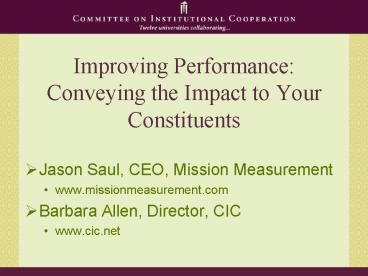Improving Performance: Conveying the Impact to Your Constituents
1 / 19
Title:
Improving Performance: Conveying the Impact to Your Constituents
Description:
Improving Performance: Conveying the Impact to Your Constituents ... Start simple; don't overtax the organization. Make measurement positive, not punitive ... –
Number of Views:42
Avg rating:3.0/5.0
Title: Improving Performance: Conveying the Impact to Your Constituents
1
Improving Performance Conveying the Impact to
Your Constituents
- Jason Saul, CEO, Mission Measurement
- www.missionmeasurement.com
- Barbara Allen, Director, CIC
- www.cic.net
2
Our Mission
- To advance academic excellence through
collaboration across our member universities.
University of Chicago University of Illinois
Indiana University University of Iowa University
of Michigan Michigan State University University
of Minnesota Northwestern University Ohio State
University Pennsylvania State University Purdue
University University of Wisconsin-Madison
3
Our inspiration
- Good to Great and the Social Sectors by Jim
Collins - The first of the five challenges he outlines for
the non-profit sector is Defining great. How do
we calibrate success without business metrics? - Staff attended a program at the Kellogg Center
for Nonprofit Management on measuring
performance featuring one Jason Saul as faculty.
4
The Challenge
- How do we know that were delivering real value?
- How do we communicate that value to members?
(ROI) - What meaningful measures can be used to evaluate
program effectiveness? - How do we motivate staff so they arent just
busy but effective? - And how do we do this within a legislative
environment?
5
The Benefits
- Increased stakeholder engagement and satisfaction
- Increased impact and program performance
- Increased satisfaction of staff (pride of
performance, investment in program improvement) - Provides a language to describe success across
staff and partner universities
6
Process
- Using process outlined in Jason Sauls book
Benchmarking for Nonprofits - Interview stakeholders
- Interview staff
- Experiment with equations
- Develop measures
- Interview stakeholders
- Interview staff
- Focus and implement
7
The Five Questions We Asked
- Phone interviews, 3-5 from each stakeholder group
(plus staff) - What impact would you like CIC to have?
- How will you know if CIC has been successful?
- How would you prioritize areas of impact?
- What data would you find valuable to describe
impact? - What one statement would you like to be able to
make about the CIC?
8
(No Transcript)
9
Messages We HeardTop Priorities
- Cost savings, cost avoidance, saving time
- Developing people and increasing academic
opportunities for faculty, staff and students - National impact and recognition of national
leadership and collaboration models
10
Messages We HeardData that would be relevant
- Cost and time savings (leveraged purchasing, but
also time/cost saved in service provisions, in
exploration of new services and service models) - Relevant data on program participants and
meetings - Longitudinal data on program impact
- Opportunity premium and other qualitative
measures of membership
11
Messages We Heard Aspirations
- We are better. together. Better individuals,
better universities and we contribute
significantly to a better American HE system
because of our innovative work together. - We are a consortium of like-minded peer research
universities with a very strong academic brand
that sets and challenges higher education
standards. - The member institutions of the CIC consistently
over-perform relative to their budgets due to
effective collaboration.
12
CIC To advance academic excellence through
collaboration across our member universities
CIC Effectiveness
Member Capacity
National Recognition
Return on Collaboration
Outcomes and Metrics
13
Impact What are you ultimately trying to
accomplish?
Priority Outcomes What changes in status,
condition or behavior are required to attain D?
Increased Faculty Interest Buy-in
Enhanced student access to courses
Increase courses available to CIC students
Increased of Students Enrolled
A B C D
A B C D
- Faculty attendance at receptions, orientations
- Number of disciplines represented in CS, TSP
participation data
- Number of students in current CS courses, in new
CS courses - Enrollments from all CS campuses
- More students using TSP
- Number CS courses offered
- Number of courses taken via TSP
- Number of LCTLs offered across CIC
Performance Measures How do we measure progress
against our outcomes?
- More promotion of courses, promotion of CS, TSP
as options for students - Reduce Hassle Factor
- Better web interface
- More faculty concalls, receptions
- Dean efforts to promote TSP, CS, LCTLs
- More receptions, info sessions to promote program
- Broader distribution of brochures
- Calls/Mtgs-Bring together more communities of
interest
Key Strategies Which programs or activities
will drive results?
14
(No Transcript)
15
Results at CIC
- We are 8 weeks into the fiscal year, and our
universities have already identified (and agreed
to fund) two new initiatives a team of Deans is
meeting with the Mellon Foundation to score
funding for another initiative. Effectively,
well see a 20 increase in their investment
during a time of downturn for all of them. - Our staff are engaged, coming up with new ways to
improve programs and working more effectively
together. - This effort is the springboard to our next
strategic framework
16
Lessons Learned
- To be effective, it has to come from the top
- Measurement is a culture, not a project
- Work within existing business processes don't
try to reinvent the wheel - Start simple don't overtax the organization
- Make measurement positive, not punitive
17
Resources
- Benchmarking for Nonprofits How to Measure,
Manage, and Improve Performance by Jason Saul
18
Resources
- Kellogg Center for Nonprofit Management (at
Northwestern University) - http//www.kellogg.northwestern.edu/research/nonpr
ofit/
19
Contact us
- Jason Saul
- 312-899-1800
- www.missionmeasurement.com
- Barbara Allen
- 217-244-9240
- www.cic.net


























![NOTE: To appreciate this presentation [and insure that it is not a mess], you need Microsoft fonts: PowerPoint PPT Presentation](https://s3.amazonaws.com/images.powershow.com/5087845.th0.jpg?_=20200513099)




